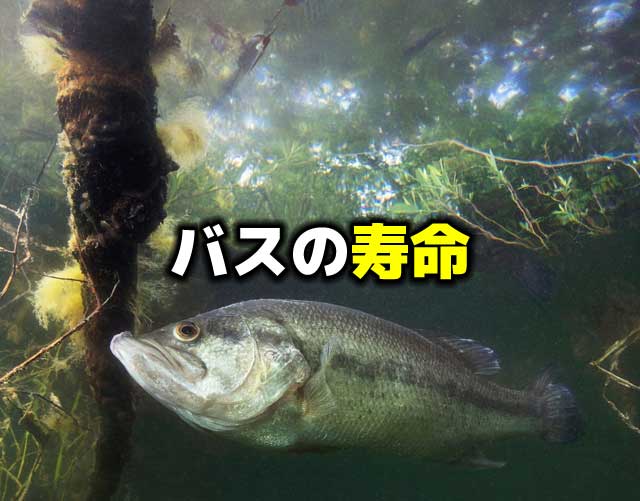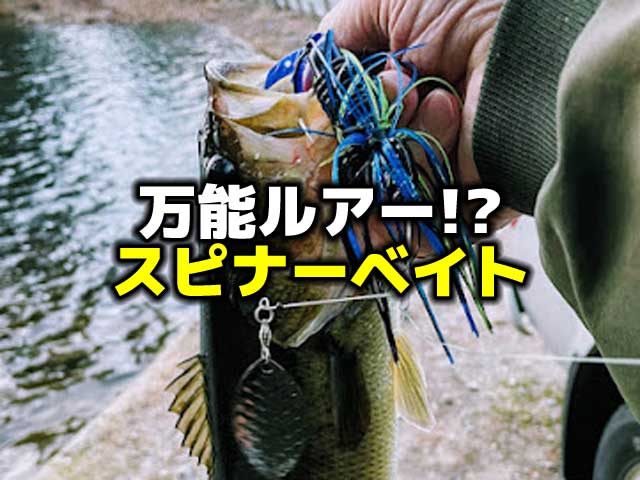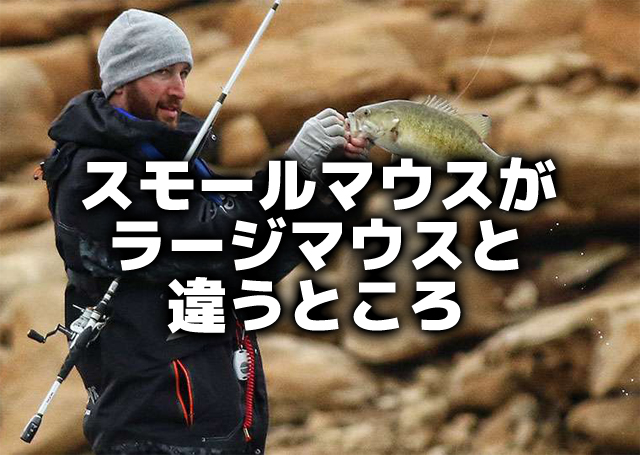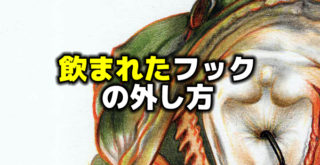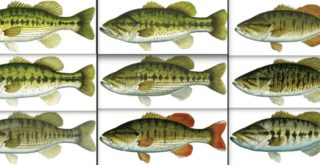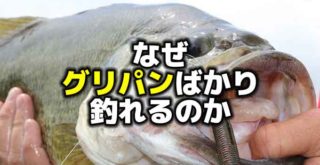水中から見たスモールマウスバスのスポーニングシーン: ダイバーが目撃した驚きの光景
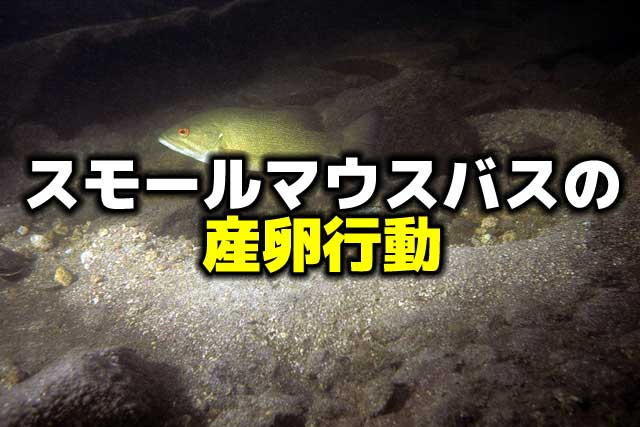
春先、スモールマウスバスの産卵シーズンに、ダイバーが水中から目撃した驚きの光景をお伝えします。オスとメスのバスの行動、卵の孵化、稚魚の成長など、バスの生態の神秘に迫ります。水中の視界が抜群に良い時期に、ダイビングで観察された貴重な体験をぜひご覧ください。
こんにちは!店長の小山です!
私が大好きなスモールマウスバスは、だいたい5月の中旬ごろから7月ごろまでネストを作り、産卵をしています。
これは大変分かりやすいバスの生態で、これほど人間の目にさらされるのはこの時期だけだと思います。
とはいえ、この見えている部分だけが産卵行動ではありませんよね。
バスはネストを作る前から行動を開始しており、ネストが見えている時期というのはむしろスポーニングの後半です。
また、野尻湖や木崎湖へ釣りに行くのも毎日のように行けるわけではないので、時々行って水中を見ては「まだネストあるな」「もうそろそろ終わりだな」ということしか言えず、たとえば1つのネスト、1匹のバスの産卵行動をはじめから終わりまで観察したことはありません。
このスモールマウスバスの産卵行動について、興味のある方はいらっしゃいますでしょうか。
この記事は、アメリカの自然を愛する教育ウェブマガジン「Nature Friend Magazine」のコラム記事で、スモールマウスバスの産卵行動の観察結果が報告されています。
これを知って直接釣果に結びつくものではありませんが、神が与えてくれた自然の中のひとつの神秘に触れてみるのも、釣り人としていいものだと思います。
ぜひ最後まで読んでみてください。
スモールマウスバスの産卵行動について
Underwater visibility is fantastic. I can see at least 30 feet (10 m) horizontally, which is superb for New England waters. I am looking for a male smallmouth bass….
In early spring when water in the shallows warms to the low-to-mid fifties Fahrenheit, the male smallmouth bass venture into shallow, rocky coves and shorelines.
The smallmouth bass I am looking for will be moving quickly, trying to coerce a female bass to the nest he has constructed on the lake bottom.
Male smallmouth bass seek an area on the bottom that has just the right mix of clean sand and cobblestones. Typically, this area will have a large rock, sunken tree, or ledge near-by. Waters where nest sites are selected are usually 6 feet (2 m) or less in depth.
The bass, satisfied with the area, will begin to sweep away coarse materials, silt, and debris with its caudal, or tail, fin. The end result will be a circular depression 2 or 3 feet (.5-1 m) in diameter and 2-4 inches (5-10 cm) deep. This process may be repeated several times in other locations before the male is satisfied with his handiwork.
As the water continues to warm between 55° and 58°, female smallmouth bass approach spawning areas from deeper water. As the females approach this area, their coloration is transformed into a series of dark vertical markings called bars. When a male sees a female, he rushes toward her and attempts to drive her to the nest site. At first the female swims rapidly away, only to return later.
The male circles the female and nips her to try to drive her to his nest. Near the nest site, the male and female circle the nest in the typical push-lead behavior.
Circling in the nest is often accomplished with the male outside the female, working their way around the nest. The female gently swings her head and tail from side to side. Occasionally she may rise from the nest in a head-down position.
After the female has laid her eggs, the male chases her away from the nest.
Now the male will either attract more females to the nest for spawning, or begin guarding the eggs.
These eggs are pale gray and yellow and are very sticky. They adhere to each other and to the stones in the bottom of the nest. Incubation takes about 10 days at 54° Fahrenheit.
The male is so protective of his brood, he will often attack on-lookers who venture too close for comfort, regardless of their size.
After about thirty minutes of searching, I notice a male trying to chase a female to the nest he has constructed! I observe the female rapidly changing colors and developing dark, vertical bars along her body. This is it!
I kick hard with my dive fins to try to keep up with the pair as he moves her over 30 feet (10 m) away to his nest site. I breathe hard through my regulator, trying to keep up with them.
The male will not feed again until the young bass leave the nest site several weeks later. He will strike at anything that enters the nest area, but only in defense of his young.
Newly hatched fry are approximately 1/5 inch (5 mm) in length and are nearly transparent. They live in the nest bottom as they gradually absorb their yolk-sacs.
As their yolk-sacs disappear, the young fry begin to feed. Now they turn jet black in color—the stage from which the name “black bass” came. Black fry rise over the nest in a dense swarm and continue to feed under the watchful eye of the guardian male.
As the size of the fry increases, the black fry slowly transform into the green fry stage, the coloration of a typical smallmouth bass. At this point, the green fry disperse into shallow, rocky areas that afford protection and food.
The male bass will now leave the nest site and begin a period of recovery, for he has not fed since spawning several weeks earlier. At this point he will return to his home range area and feed on crayfish, minnows and other available small fish.
In approximately five years, the fry will be mature and ready to spawn.
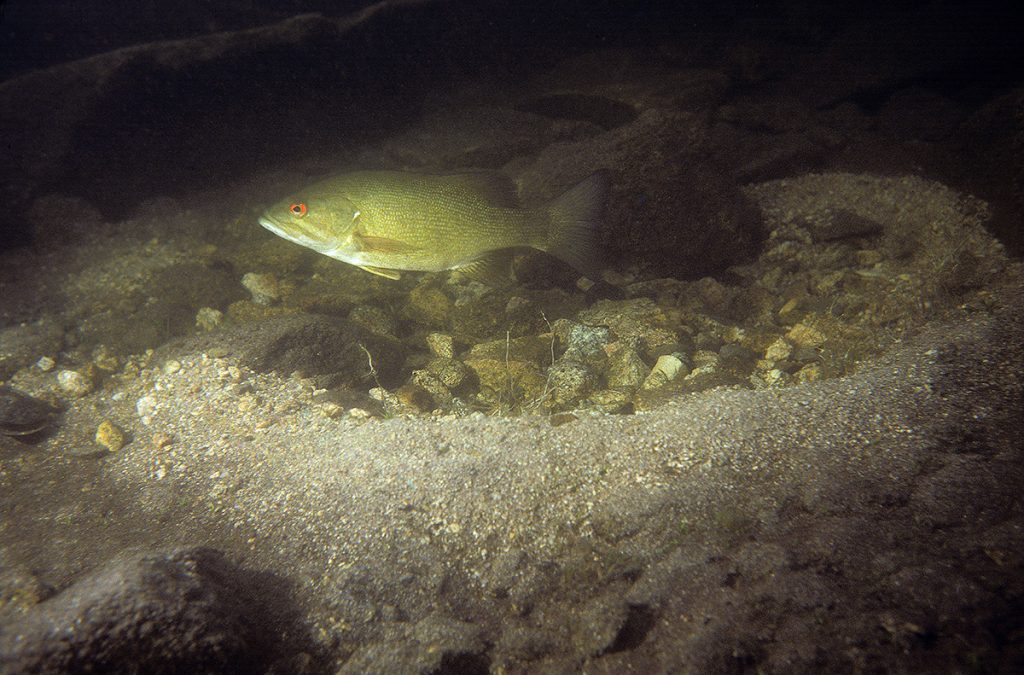
見てくださいこの素晴らしい水中の視界。水平方向に少なくとも30フィート(10m)先まで見渡せるのは、ニューイングランドのフィールドでは抜群の透明度だと言えるでしょう。私は今、オスのスモールマウスバスを見つけたところです…。
春先、シャローの水温が10℃~12℃あたりまで上昇すると、オスのスモールマウスバスは岩の多いシャローのワンドやバンクに向かって進んでいきます。
私が見つけたこのスモールマウスバスは、湖底に作ったネストにメスのバスを誘い込もうと行動している最中でしょう。
オスのスモールマウスバスは、砂と砂利がいい感じに混じり合った清潔な場所を湖底に求めます。通常、そのような場所には大きな岩や沈んだ木、岩盤などが近くにあるものです。ネスト作りに選ばれる水深は通常、水深6フィート(2m)以下です。
バスは、納得のいく場所を見つけると、尾ビレを使って泥やゴミなどを掃き出し始めます。その結果、直径2~3フィート(0.5~1m)、深さ2~4インチ(5~10cm)の円形の窪みができあがります。オスは自分が作るネストに満足するまでに、他の場所でもこの作業を何度か繰り返すことがあります。
水温が13℃~14℃の間あたりまで上昇すると、メスのスモールマウスバスがディープエリアからスポーニングエリアに近づいてきます。メスがこのエリアに近づくとき、体色が変化し、バーと呼ばれる暗い縞模様が現れます。オスがメスを見つけると、そのメスに向かって突進し、ネストへと誘い込もうとします。最初、メスはすぐに逃げますが、後でまた戻ってきます。
オスはメスの周りを回り、メスをつついてネストに追い込もうとします。ネストの近くでは、オスとメスが典型的なプッシュ・リード行動でネストの周りを回ります。
ネストの中を回る際、オスはメスの外側を回ることが多く、二匹でネストの周りを回ります。メスは頭と尾をそっと左右に振ります。時折、メスは頭を下にした状態で巣から浮き上がることもあります。
メスが卵を産み終えると、オスは彼女をネストから追い払います。
次にオスはさらに別のメスをネストに誘い込んで産卵させるか、卵を守り始めます。
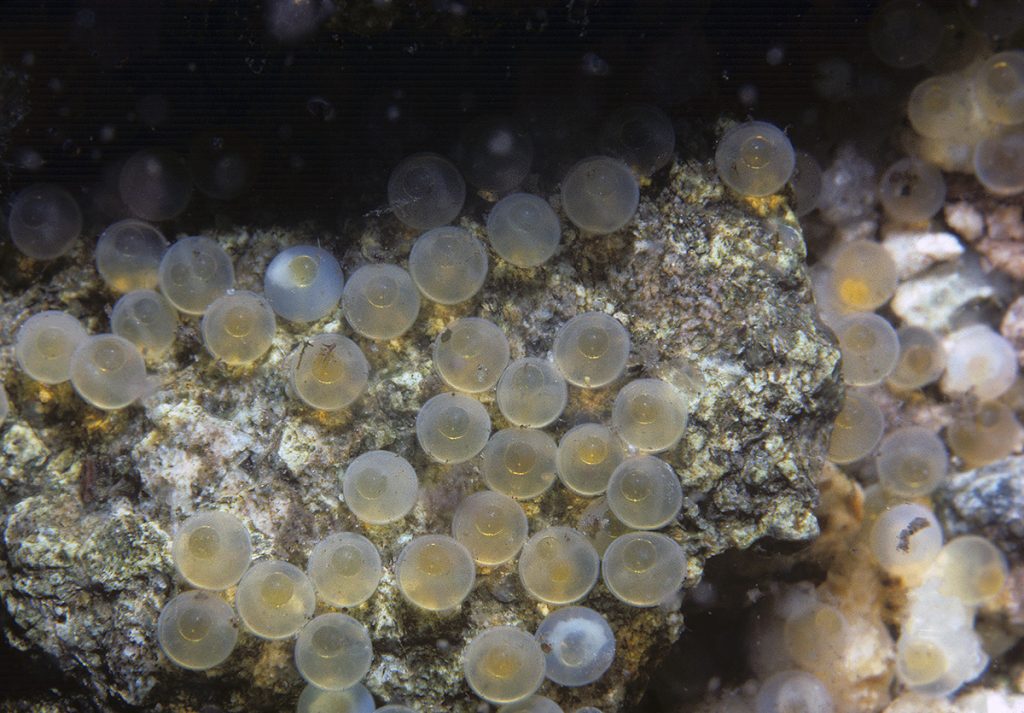
スモールマウスバスの卵は薄い灰色と黄色で、粘着性があります。卵は互いにくっつき合い、ネストの底にある石にもくっつきます。孵化には12.2℃の水温で約10日かかります。
オスは自分の子を守ることに必死で、近づこうとするものを大きさに関係なく攻撃することがよくあります。
約30分の観察の後、私はオスが自分の作ったネストにメスを誘い込もうとしているの場面に遭遇しました!これです!メスは急速に体色を変え、体に暗い縞もようが現れるのを観察しました。
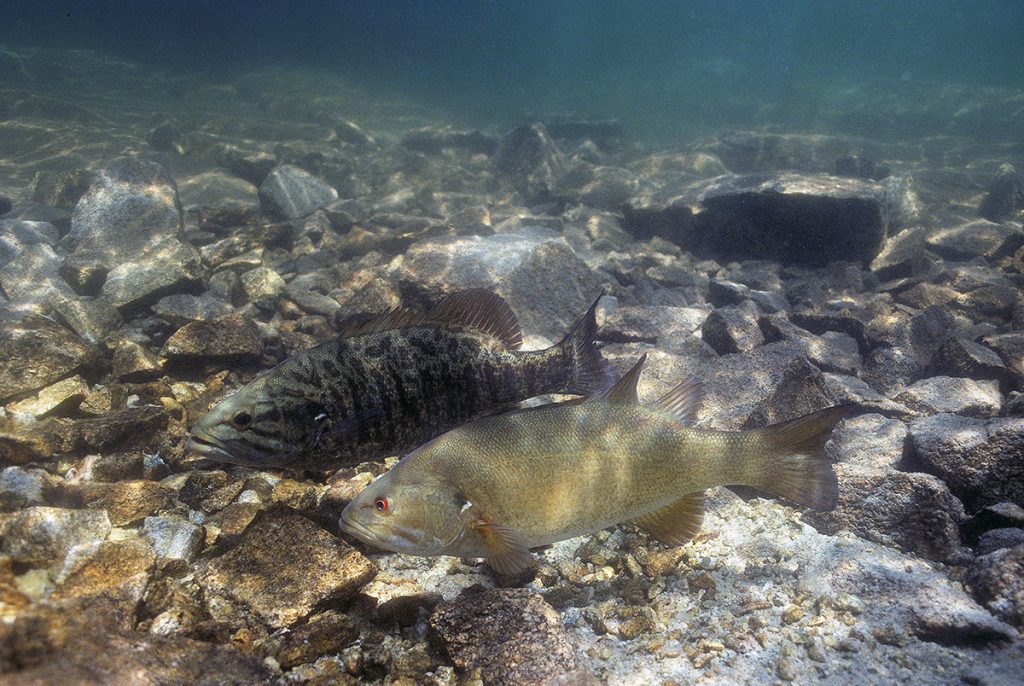
私は一生懸命泳ぎ、オスがメスを30フィート(10m)以上離れたネストまで連れて行くのについていこうとしました。酸素ボンベを背負っているので、必死です!
オスは、数週間後に幼魚がネストを離れるまで、フィーディングをすることはありません。ネストに入ってくるものは何でも攻撃しますが、それは幼魚を守るためだけです。
孵化したばかりの稚魚は長さ約1/5インチ(5mm)で、ほぼ透明です。彼らは卵黄嚢を徐々に吸収しながら、ネストの底で生活します。
卵黄嚢がなくなると、稚魚は餌を食べ始めます。この時、彼らは真っ黒な色に変わります。これが「ブラックバス」という名前の由来になった段階です。黒い稚魚はネストの上で密集した群れを作って泳ぎ、守護者であるオスの監視の下で餌を食べ続けます。
稚魚の大きさが増すにつれ、黒い稚魚はゆっくりと緑色の稚魚段階へと変化していきます。いわゆるスモールマウスバスの色合いです。この時点で、緑色の稚魚は保護と食料が得られる岩場のシャローに散っていきます。
そうなったところでオスのバスはネストを離れ、回復の時期に入ります。産卵してから数週間、彼は餌を食べていなかったのです。この時点で、彼はいつもの場所に戻り、ザリガニや小魚、その他の小さな魚を餌にします。
約5年後、稚魚は成熟し、産卵の準備が整います。
スモールマウスバスの営みを発見したダイバーが興奮している様子が書かれているのが印象的でしたね。
オスのバスはネストづくりから始まり、メスが産卵してから10日間と、稚魚が孵ってからの数週間も、何も食べずに卵と稚魚を守っているのですね。
私たちアングラーのほとんどはこのようなことは何も知らず釣りをしていますが、アメリカの北部やカナダではスモールマウスバスを守るためにスポーニング時期は禁漁になるそうですね。
私もスポーニングシーズンにバス釣りはしますから、日本もそうしようと言いたいわけではありません。でも、このような営みを知ると、やっぱり愛おしくなりますよね。
個人的にはネストのバスを釣った時や、スポーニングシーズンに釣ったときはライブウェルに入れず、サイズ計測や写真撮影は最小限にして、いつもより素早くリリースするよう心掛けています。
しかし、それもひとつの身勝手なエゴといいますか、矛盾があるわけで、この時期になるとどうしてもそういうジレンマがつきまとってしまいます。
みなさんもそれぞれにゲームフィッシングに対する複雑な想いがあるかと思いますが、みなさんがそれぞれ優しくあっていただければいいなと思います。
もちろん、禁漁区や禁漁期間が決まっている場所ではルールは守りましょうね。
みなさんはこの記事で何を感じましたか?
それではまた。
毎度ありがとうございます!
